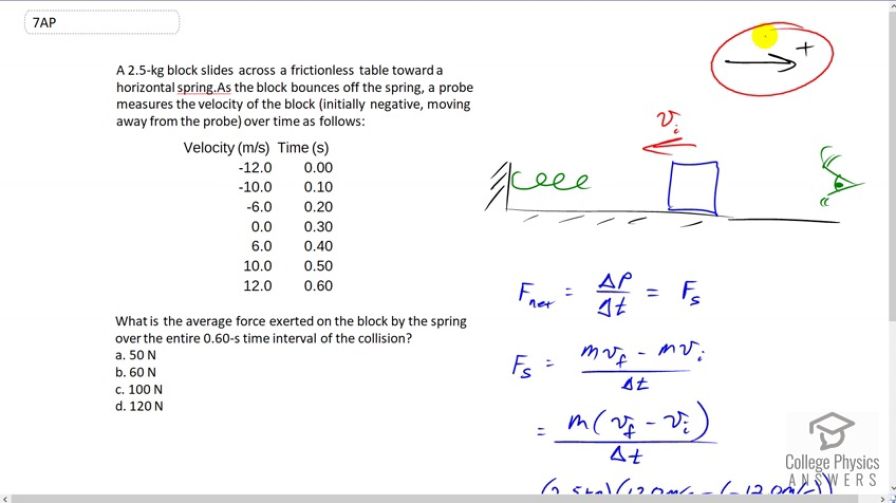Question
A 2.5-kg block slides across a frictionless table toward a horizontal spring.As the block bounces off the spring, a probe measures the velocity of the block (initially negative, moving away from the probe) over time as follows:
What is the average force exerted on the block by the spring over the entire 0.60-s time interval of the collision?
| Velocity (m/s) | Time (s) |
|---|---|
| -12.0 | 0 |
| -10.0 | 0.10 |
| -6.0 | 0.20 |
| 0 | 0.30 |
| 6.0 | 0.40 |
| 10.0 | 0.50 |
| 12.0 | 0.60 |
- 50 N
- 60 N
- 100 N
- 120 N
Final Answer
(c)
Solution video
OpenStax College Physics for AP® Courses, Chapter 8, Problem 7 (Test Prep for AP® Courses)

vote with a rating of
votes with an average rating of
.
Calculator Screenshots
Video Transcript
This is College Physics Answers with Shaun Dychko. The observer watches this block initially moving away to the left and that is in the negative direction because we'll take positive to the right. Then the block contacts a spring and the spring eventually makes the block start to go back towards the observer. So initially the block is moving away at 12 meters per second and then it's moving towards the observer at 12 meters per second after 0.6 seconds of contact with the spring. So the net force on the block is its change in momentum over change in time and the net force in the x direction will be the spring force because there is only one force horizontally acting on this block after it contacts the spring. That will be in this direction, and the gravity and the normal force don't matter because they are perpendicular to the velocity, so they have no effect on it. So, we'll have the spring force is going to be the mass times final velocity, minus mass times initial velocity over the time during which the force is acting. We can factor out the common factor m and that's going to be m times vf minus vi over delta t. We're told that the mass is 2.5 kilograms times a final velocity of 12 meters per second, minus and initial velocity of negative 12. This makes 24 in the bracket there, and divided by 0.6 seconds gives us 100 newtons, so the answer is C.
